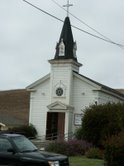From: Coastside Cultural Resources of San Mateo County
(Photo of Saint Anthony’s by John Vonderlin)
“The village of Pescadero is one of the most historic areas in the County and has the most distinctive character of any community on the Coastside.
“Along its streets can still be seen a variety of 19th century architectural forms and styles which developed during a time of prosperity between the forms and styles which developed during a time of prosperity between the 1860s and 1890s when the town served as a major produce and lumber center and summer resort for San Francisco.
“The spires of St. Anthony’s and the Congregational Church rising above a cluster of houses and commercial structures give Pescadero a resemblance to a trim New England village. Although this image has lessened in recent years, as a result of fires, new construction and alterations which are not in character with the town, Pescadero still retains essentially the village it must have been in 1890.
“Since Pescadero’s early days, people have noted an architectural unity in the community which set it off from other villages. This unity is still in evidence today. There are several possible explanations for this architectural unity. An unusual number of the original settlers came from Maine. They no doubt brought with them fairly strong ideas about the proper appearance of a village. Also, the relative isolation of the village may have kept their ideas from being diluted by innovations from the outside. The unity of style may also have resulted from the effect on newcomers of a few particularly pleasing houses already in the community.
“Alexander Moore, son of a pioneer family in the area, built one of the first houses in Pescadero in 1853. His home, which burned in 1975, was constructed along vaguely classical lines in Greek Revival style. This house may well have been the model by which subsequent buildings were judged. In any case, its Greek Revival character appears throughout Pescadero with numerous variations, giving the village a style which is still dominant.
“An outstanding example of this character can be seen along the east side of Stage Road on the block immediately south of Pescadero Road. The wooden structures that remain there are residential, civic and religious examples of indigenous Coastside architecture. The sparing but effective use of ornamentation such as pierced columns, scroll and fan brackets, cresting, shingling, assorted fenestration and balustrades indicates a clear understanding of the styles of the time and creative application of those styles to local needs. Although alterned somewhat in appearance and usage, these buildings accurately reflect a village landscape of a significant period in the history of San Mateo County.”

